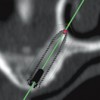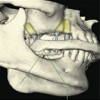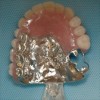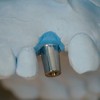Some obturator prostheses may lack sufficient extension or adaptation at the time of delivery to prevent leakage of fluids of food bolus into the defect upon swallowing. In other patients, speech may be suboptimal. This program describes and illustrates the methods used to determine causation and the means of correction. It details reline procedures, design and fabrication of obturator prostheses for traumatic defects, obturator design for patients with large orbital defects, lid designs and a number of other issue unique to obturator prostheses.
Maxillofacial Prosthetics – Maxillary Obturators Trouble Shooting, Relines and other issues — Course Transcript
- 1. Maxillary obturatorsTrouble shooting, relines and other issues John Beumer III, DDS,MS Division of Advanced Prosthodontics UCLA School of DentistryAll rights reserved. This program of instruction is protected by copyright ©. Nopart of this program of instruction may be reproduced, or transmitted by anymeans, electronic, digital , photographic, mechanical etc., or by any informationstorage or retrieval system, without prior written permission from the authors.
- 2. RelinesThermoplastic wax is recommended Principal advantage: The clinician is less likely to make impressions that inadvertentlydisplace tissues resulting in fewer postreline adjustments.
- 3. RelinesProsthodontic ProceduresThe acrylic resin is cut back 1-2 mm.Strategic undercuts are removedContours in the undercut areas are redevelopedwith dental compoundThe impression wax is heated and painted ontothe surface of the obturator with a PIP brushThe prosthesis is inserted and the patient askedto make eccentric mandibular movements.
- 4. Relines (cont’d)If needed the velopharyngeal musculature is activatedAfter a few minutes, the prosthesis is removed andproper tissue adaptation verified. If areas of the acrylicresin are exposed, these areas are reduced further andadditional wax is applied.During border molding and refinement of the impression,occlusal relationships and the vertical dimension ofocclusion must be maintained.The wax lined prosthesis is reinserted for 60-90 minutesfor further molding.The reline impression is removed, chilled and processedin autopolymerizing acrylic resin
- 5. Relines – Complete Dentures and ObturatorNote the amount of acrylic resinremoved from the surface of theobturator. The undercuts have beenremoved and a finish line has alsobeen created. Completed reline impressions Note the extension onto the nasal side of the soft palate (arrow).
- 6. Relines – Complete Dentures and Obturatorl This complete denture and obturator retained with a single implant was relined with thermoplastic wax.
- 7. Relines – RPD with Obturatorl The obturator portion is aggressively reduced by approximately 2 mm.The completed reline in thermoplastic wax.
- 8. Relines – RPD with Obturator l The reline impression is removed, carefully inspected, flasked and the reline is accomplished with autopolymerizing acrylic resin.A small extension onto the nasal side of the soft palatewill reduce leakage of fluids into the nasal passage.
- 9. Additional issues of interesta) Unusual defectsb) Prevention of leakagec) Engagement of the nasal side of the soft palate during soft palate elevationd) Obturators that extend to the posterior pharyngeal walle) Relationship to the torus tubarisf) Extensions into an orbital exenteration defectg) Uplifting the orbital contents to eliminate double visionh) Lid or no lidi) Hollowing the obturator bulb
- 10. Small Partial Palatectomy DefectsImpressions for RPD frameworks l Small defects should be packed with gauze to avoid impacting impression material into the defect
- 11. Partial Palatectomy Defectsv Junction hard palate – soft palate defects To maintain seal, an extension (arrow) must be developed which engages the nasal side of the soft palate when the soft palate elevates.
- 12. Partial Palatectomy Defectsv Anterior Defects In these defects a scar band is usually present at the junction of the oral and nasal mucosa. It is difficult to develop normal lip contours in such defects because of wound contraction. The use of a skin graft results in less wound contraction and allows for the development of ideal lip contours and should be encouraged.
- 13. Partial Palatectomy Defectsv Anterior defects Mounted casts showingMaster cast extent of the defect The prosthesis is in position. It was extended as far superiorly without interfering with nasal breathing. The mustache hid the deficient lip contours secondary to contracture of the upper lip.
- 14. Partial Palatectomy Defectsv Anterior defects
- 15. Traumatic DefectsThese defects are difficult to restore. Why?a) Poor quality mucosa lines the defectb) Defects are irregular in size and shapec) Scarring of tissues adjacent to the defectd) Residual maxillary segments may be displacede) Misalignment of the mandibular dentition complicate the occlusal relationships
- 16. Traumatic Defectsv A traumatic defect secondary to a gunshot wound Note the poor quality mucosa lining the defect, its irregular shape and the scarring of tissues adjacent to the defect. Only the maxillary second molar remains.
- 17. Traumatic Defects A traumatic defect secondary to self inflicted gunshot woundNote the poor quality mucosa lines the defect its, irregular shape and the scarring of tissues adjacent to the defect. The residual maxillary segments are displaced and the mandibular fragments are misaligned.
- 18. Traumatic Defects ImpressionsMucostatic impressions made with a thermoplastic wax arepreferred. With this method the stability, retention and supportderived from the defect can by maximized. An occlusal index is required when this method of impression making is employed.
- 19. Traumatic DefectsThe altered cast of the defect is shown. Before completingthe prosthesis the removable partial denture frameworkneeds to be physiologically adjusted very carefully to allowfor movement of the prosthesis secondary to the forces ofocclusion.
- 20. Traumatic DefectsFortunately there was a significant undercut posteriorly andlaterally on the left side of the defect (arrows).The solitary molar retained the prosthesis in the right posteriorregion and engagement of the undercuts referred to abovefacilitated retention posteriorly and on the left side of the defect.
- 21. Traumatic DefectsThe molar had a useful life of 11 years after deliveryof the prosthesis after which time it was replacedwith a solitary osseointegrated implant with an “O”ring attachment.
- 22. Prevention of leakagel Most leakage occurs posteriorly at the midline. Liquids accumulate in the bulb and spill out when the patient tips their head forward, or they travel along the surface of the palate and exit the nose anteriorly.This extension is too short on the obturator on the left(arrows). Solution – Increase the vertical height of theposterior medial portion of the obturator (oval).
- 23. Prevention of leakagev This small addition with Rim Seal (ovals) was sufficient to eliminate leakage in this patient
- 24. Extensions onto the nasal side of the soft palatev Such an extension is necessary if the defectDuring speech and swallowing, as the soft palateelevates, contact with the obturator is maintained,minimizing leakage of air and liquids.
- 25. Maxillectomy defects that extend to the posterior pharyngeal wall in edentulous patientsl Challenge: l Retention l Accurate positioning of the velopharyngeal segment Ramus imprint Velopharyngeal extension These obturators are very large, are subject to a great deal of movement, and these patients need osseointegrated implants to retain the obturator effectively.
- 26. Maxillectomy defects that extend to the posterior pharyngeal wall in edentulous patients Velopharyngeal extension The velopharyngeal extension must fit precisely into the zone of contraction of the residual elements of the veli levator palatini, present within the lateral pharyngeal wall, if speech is to be restored to normal. Implants provides retention and maintains accurate positioning of this extension.
- 27. Relationship with torus tubaris v A large defect extending into the velopharyngeal area. The obturator should not touch the torusThe impression wax has flowed into thisarea but this extension was removed inthe processed obturator prosthesis.
- 28. Obturator extension into large orbital defects A BThe obturator extension should terminate short of the height ofcontour leading to the of facial portion of the defect. Otherwise,as was the case in patient “A”, saliva will spill onto the skin anddown the cheek because of capillary attraction (arrows). Patient“B” had no such difficulty.
- 29. Lifting the orbital contentsCan the orbital contents belifted with an obturatorprosthesis when the orbitalfloor is resected?v Generally not effective even in dentulous patients. It is best that the orbital floor be reconstructed surgically.v Patients generally accommodate and the vision returns to normal.
- 30. Lids for obturatorsv Lids are provided when secretions accumulate in the defectv Most radical maxillectomy defects that are skin lined do not require lidsv Most defects that are irradiated do not require lidsv Lids must be contoured so that secretions are directed posteriorly (arrows)
- 31. Hollowing the obturatorThis task is completed only after the first followupappointment and after all the major adjustmentshave been completed.
- 32. v Visit ffofr.org for hundreds of additional lectures on Complete Dentures, Implant Dentistry, Removable Partial Dentures, Esthetic Dentistry and Maxillofacial Prosthetics.v The lectures are free.v Our objective is to create the best and most comprehensive online programs of instruction in Prosthodontics


 Prosthodontic Procedures and Complications
Prosthodontic Procedures and Complications
 Angled Implants
Angled Implants
 Implants and RPDs
Implants and RPDs
 Cement Retention vs Screw Retention
Cement Retention vs Screw Retention
